Traditional Thai Cuisine A Cultural Treasure Worth Preserving
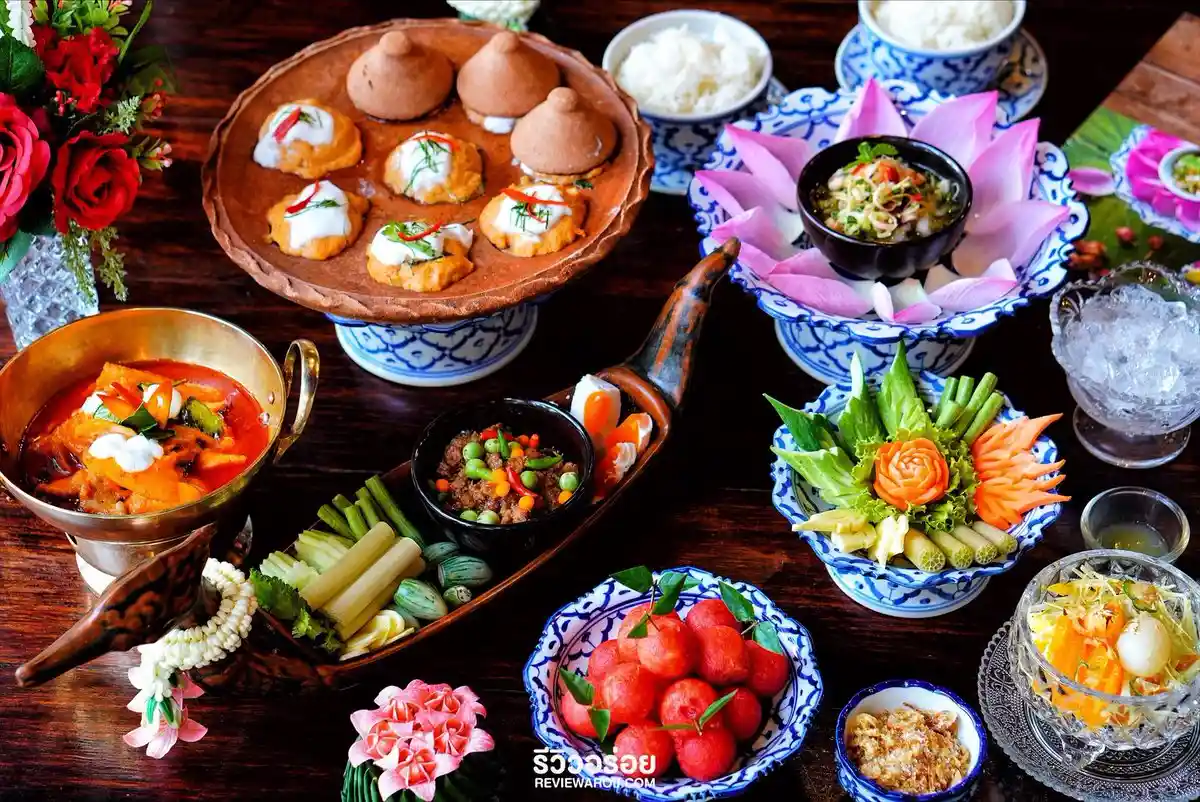
Rating: 5/5 (6 votes)
Bangkok attractions
Attractions in Thailand
Traditional Thai Cuisine: A Cultural Treasure Worth Preserving Traditional Thai cuisine is one of the world's most renowned cultural treasures. With its diverse flavors and the use of fresh ingredients, Thai food not only reflects the deliciousness and beauty of culinary arts but also plays a significant role in the traditions and way of life of the Thai people. In this article, we will explore the history and importance of traditional Thai cuisine, as well as popular dishes that both Thais and foreigners should know.
History and Origins of Traditional Thai Cuisine The history of traditional Thai cuisine is rich with evolution through various eras, influenced by diverse cultures, including Indian, Chinese, and Mon influences. This blend has given Thai food its complex flavors and diversity in preparation methods and ingredient use, which align with Thailand's geography and climate.
The tradition of passing down Thai cuisine from generation to generation has preserved the original cooking methods, making Thai food uniquely distinct and continuously popular both domestically and internationally.
Regional Diversity of Traditional Thai Cuisine Traditional Thai cuisine varies across different regions of the country, reflecting the culture and history of each locality.
Central Thai Cuisine: Balanced flavors, such as Tom Yum Goong and Green Curry, showcase the complexity in ingredient use and preparation.
Northern Thai Cuisine: Milder flavors, such as Khao Soi and Kaeng Hang Le, which are influenced by Burmese and Lanna cultures.
Northeastern Thai Cuisine: Emphasizes spicy and sour tastes, like Som Tum and Laab, reflecting simplicity yet intense flavors.
Southern Thai Cuisine: Known for its bold and spicy flavors, such as Yellow Curry and Kua Kling, with heavy use of spices and coconut milk.
Flavors and Ingredients in Traditional Thai Cuisine The flavors of traditional Thai cuisine are a harmonious blend of spicy, sweet, sour, salty, and bitter, creating a perfect balance. Thai cuisine often incorporates local herbs like lemongrass, kaffir lime leaves, and galangal. These ingredients not only enhance the flavor but also provide nutritional value and health benefits.
Coconut milk is a crucial ingredient in traditional Thai cuisine, especially in curries and desserts. It adds richness and a fragrant, creamy taste, giving Thai dishes their distinctive character.
Cooking Methods in Traditional Thai Cuisine Preparing traditional Thai dishes requires precision and skill in ingredient preparation, such as pounding curry paste, which demands strength and technique. Flavoring relies on tasting and adjusting to achieve balance, and controlling the heat during cooking is also crucial to getting the right taste and texture.
Must-Know Traditional Thai Dishes
Tom Yum Goong (Spicy Shrimp Soup)
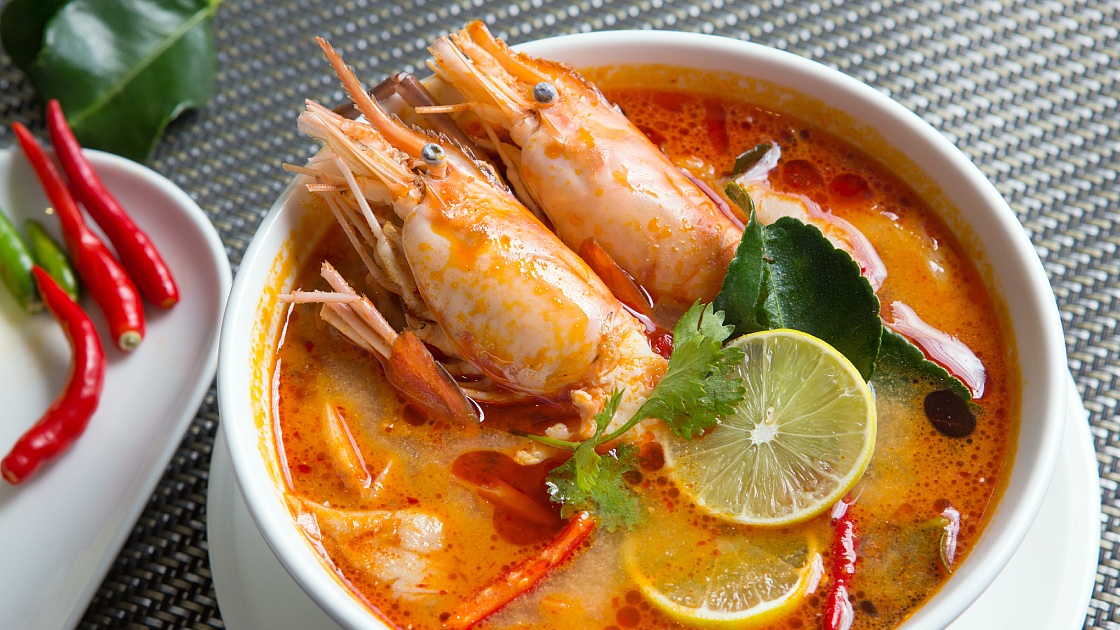
Ingredients:
- 300g fresh shrimp
- 100g straw mushrooms
- 2 stalks lemongrass
- 3 slices galangal
- 3 kaffir lime leaves
- 5 bird's eye chilies
- 2 tbsp lime juice
- 2 tbsp fish sauce
- 1 cup milk
- 2 cups chicken broth
Instructions:
- Boil the chicken broth in a pot until it boils, then add lemongrass, galangal, and kaffir lime leaves.
- Add the shrimp and mushrooms to the broth, cooking until the shrimp is done.
- Season with fish sauce, lime juice, and crushed chilies.
- Add milk for a richer flavor, stir well, turn off the heat, and serve immediately.
Green Curry (Gaeng Keow Wan)
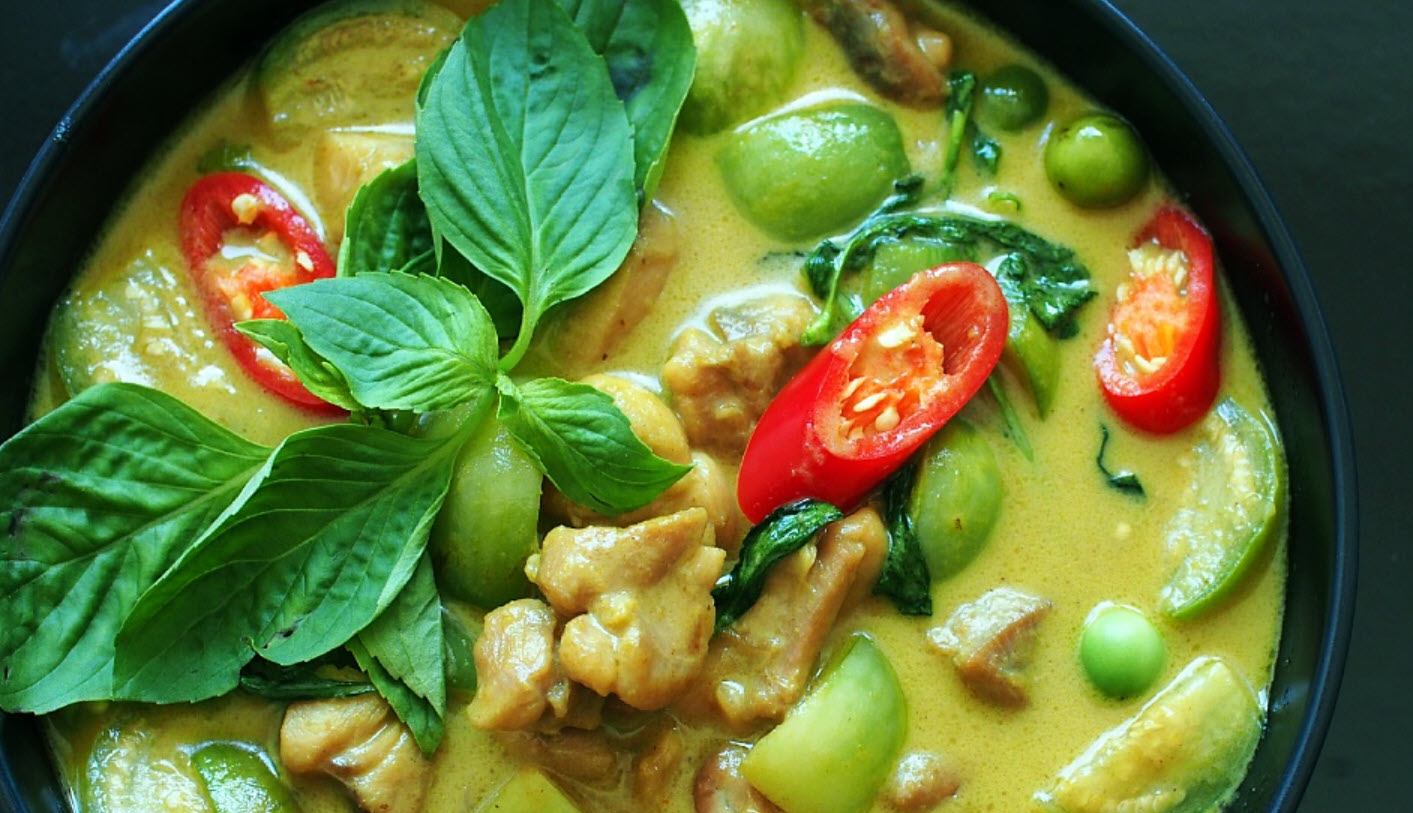
Ingredients:
- 300g chicken
- 50g pea eggplants
- 100g Thai eggplants
- 1 handful sweet basil
- 2 chili peppers
- 2 cups coconut milk
- 2 tbsp fish sauce
- 1 tbsp palm sugar
- 3 tbsp green curry paste
Instructions:
- Saute the green curry paste in the thick part of the coconut milk until fragrant and the oil separates.
- Add chicken, stir until cooked, then pour in the thin coconut milk and bring to a boil.
- Add the eggplants, cooking until tender.
- Season with fish sauce and palm sugar, then add sweet basil and sliced chili peppers. Turn off the heat and serve with hot steamed rice.
Som Tum (Spicy Papaya Salad)
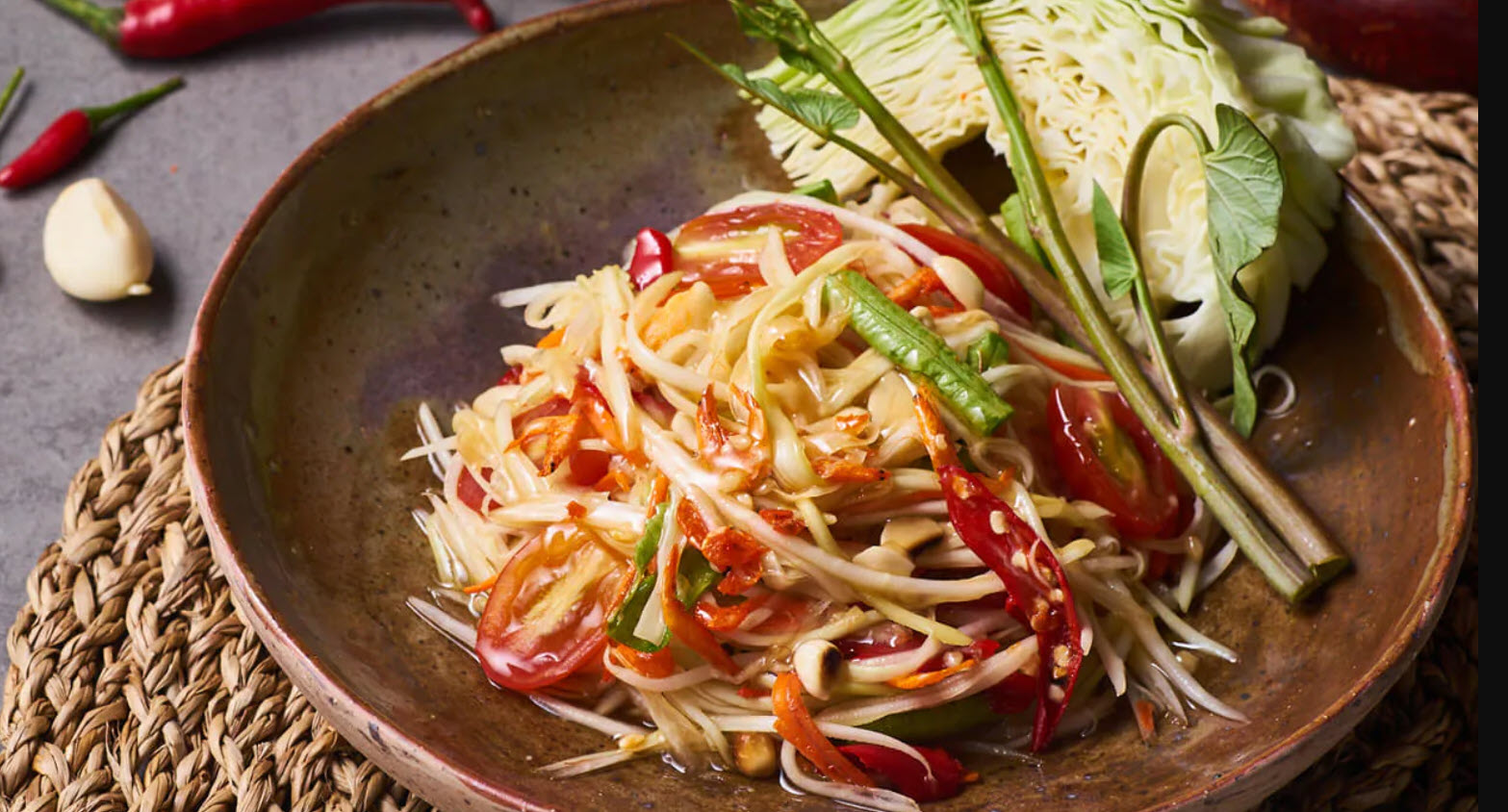
Ingredients:
- 1 cup shredded green papaya
- 2 tomatoes
- 2 long beans
- 3 cloves garlic
- 5 bird's eye chilies
- 2 tbsp fish sauce
- 2 tbsp lime juice
- 1 tbsp palm sugar
- 2 tbsp roasted peanuts
Instructions:
- Pound the garlic and chilies together in a mortar.
- Add long beans, tomatoes, and shredded papaya, then gently pound to mix.
- Season with fish sauce, lime juice, and palm sugar, then pound lightly to combine.
- Serve with roasted peanuts on top.
Khao Soi (Northern Thai Curry Noodles)
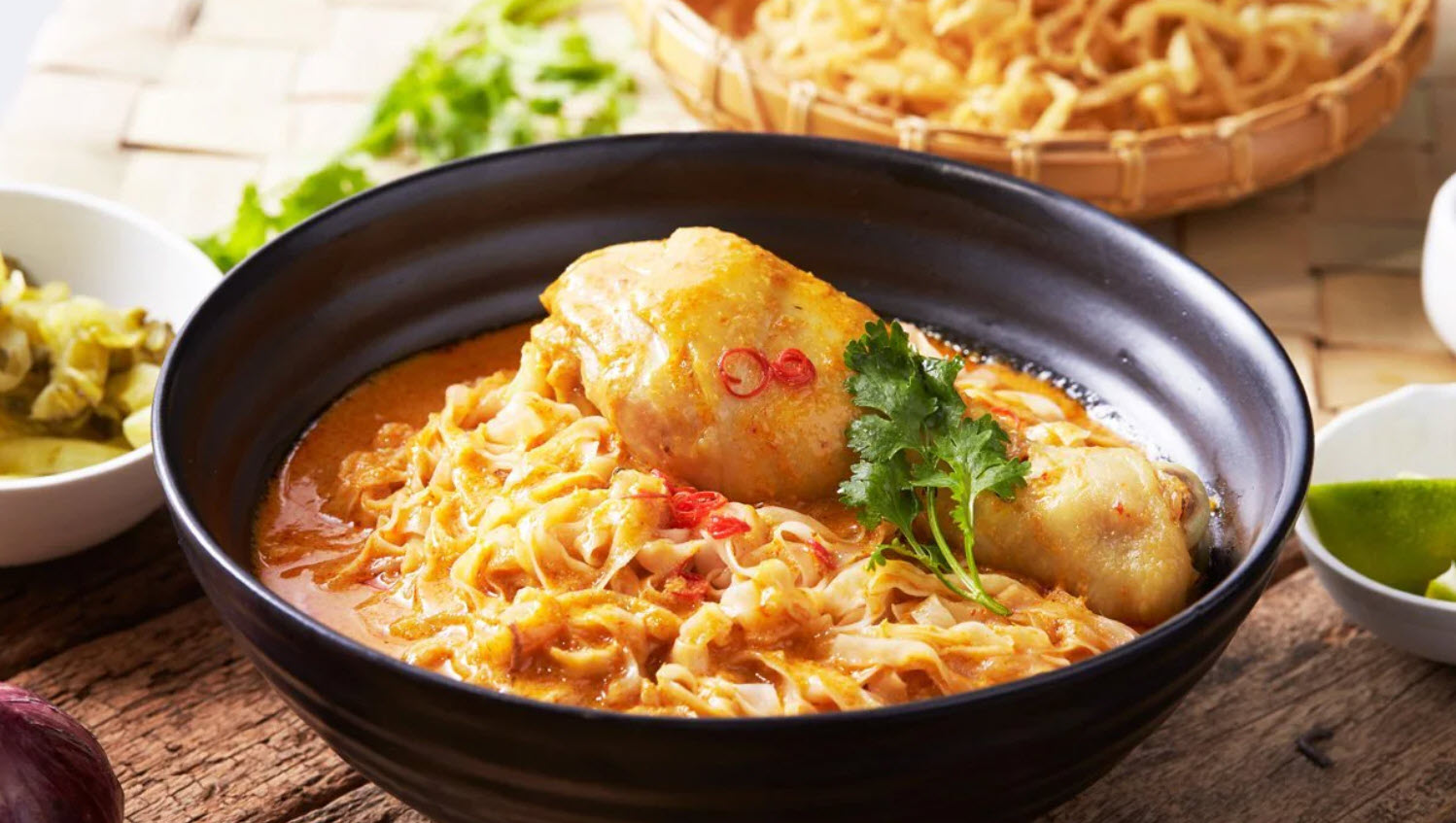
Ingredients:
- 300g chicken
- 200g Khao Soi noodles
- 3 tbsp Khao Soi curry paste
- 2 cups coconut milk
- 2 cups chicken broth
- 2 tbsp fish sauce
- 1 tbsp palm sugar
- Lime, pickled mustard greens, sliced shallots, dried chili
Instructions:
- Saute the Khao Soi curry paste in thick coconut milk until fragrant.
- Add chicken and chicken broth, simmer until the chicken is tender.
- Add thin coconut milk and Khao Soi noodles, simmer until the noodles are done.
- Season with fish sauce and palm sugar, stir well.
- Serve in a bowl with lime, pickled mustard greens, sliced shallots, and dried chili on the side.
Pad Thai (Stir-Fried Noodles)
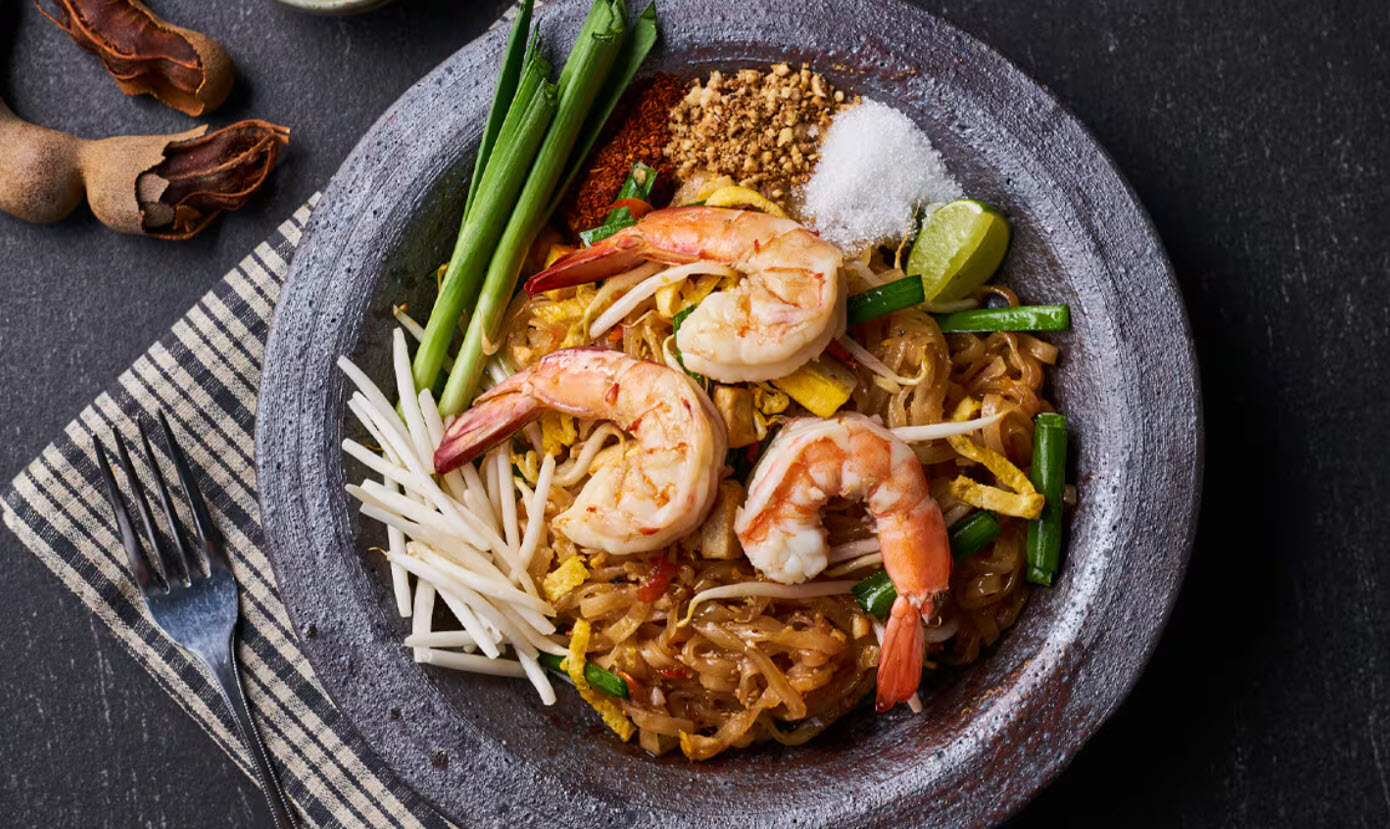
Ingredients:
- 200g Pad Thai noodles
- 200g fresh shrimp
- 100g firm tofu
- 1 cup bean sprouts
- 1 egg
- 2 tbsp vegetable oil
- 2 tbsp palm sugar
- 2 tbsp fish sauce
- 2 tbsp tamarind paste
- 2 tbsp roasted peanuts
- 1 handful chopped chives
Instructions:
- Heat vegetable oil in a wok, add tofu and shrimp, stir-fry until cooked.
- Add Pad Thai noodles and an egg, stir-fry until the egg is done.
- Season with palm sugar, fish sauce, and tamarind paste, stir well.
- Add bean sprouts and chopped chives, toss to combine.
- Serve on a plate, garnish with roasted peanuts and chili powder as desired.
Preservation and Transmission of Traditional Thai Cuisine Preserving traditional Thai cuisine is highly valued among Thais. Teaching Thai cooking within families and sharing recipes through various media ensures that future generations can learn and maintain Thai culinary traditions. Additionally, cultural festivals and the promotion of cultural tourism play vital roles in spreading Thai cuisine to the global stage.
Traditional Thai cuisine is not only delicious with its distinctive flavors but also a cultural treasure reflecting the Thai way of life and history. Preserving and passing down traditional Thai cuisine is a mission that every Thai should be part of, ensuring that Thai culinary culture remains well-known and cherished worldwide.
How Traditional Thai Food Benefits Health Traditional Thai food offers numerous health benefits due to its use of natural ingredients and a wide variety of herbs, which not only enhance the flavor of the dishes but also provide medicinal properties and nutritional value. Here are some key health benefits of Thai cuisine:
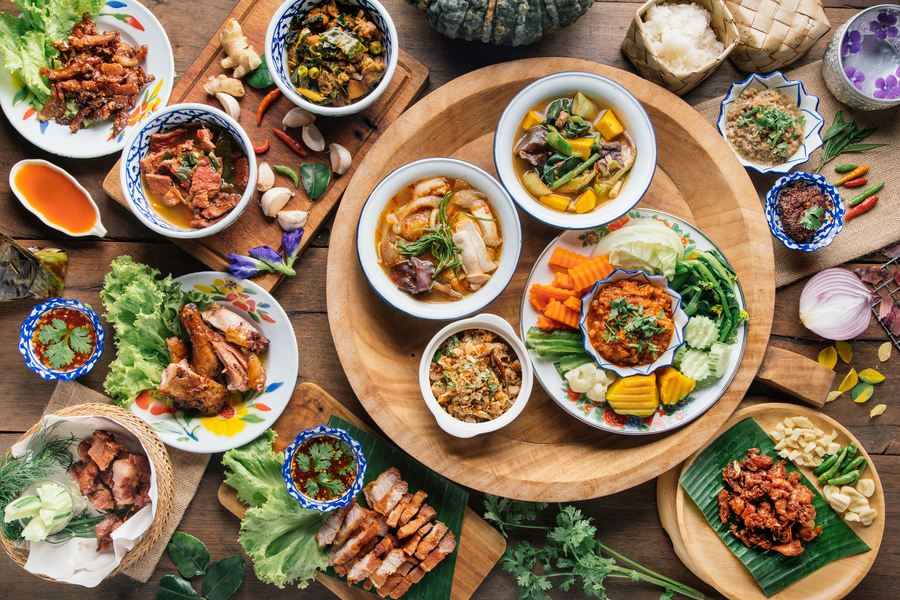
1. Herbs and Spices with Medicinal Properties
Lemongrass: Contains compounds that help reduce inflammation, relieve bloating, and lower blood pressure.
Galangal: Known for its ability to alleviate indigestion, reduce gas, and stimulate digestion.
Ginger: Helps reduce nausea, relieve headaches, and has anti-inflammatory properties.
Kaffir Lime Leaves: Known for their ability to reduce stress, relieve colds, and aid digestion.
Chilies: Contain capsaicin, which boosts metabolism, reduces the risk of heart disease, and aids digestion.
2. Low Oil Usage Many Thai dishes, such as Tom Yum and Gaeng Som (Sour Curry), are prepared with minimal oil, which helps reduce the intake of saturated fats, promoting heart and vascular health.
3. High Fiber Content Thai food often includes a variety of fresh vegetables and fruits, such as Som Tum (Spicy Papaya Salad) made with papaya or herbal salads, which increase fiber intake, aid digestion, prevent constipation, and help regulate blood sugar levels.
4. Fresh Ingredient Consumption Thai cuisine emphasizes the use of fresh ingredients like vegetables, fish, and herbs, which provide essential nutrients and high nutritional value to the body.
5. Balanced Flavors Thai dishes are known for their balanced combination of flavors—sour, sweet, salty, and spicy. This diversity of flavors stimulates saliva and digestive juices, enhancing digestion.
6. Weight Management Many Thai dishes, such as Tom Yum, Som Tum, and Kaeng Liang (Spicy Vegetable Soup), are low in calories and high in fiber, making them effective for weight management and promoting a sense of fullness.
7. Rich in Vitamins and Minerals Herbs and vegetables used in Thai cuisine, such as basil, coriander, and mint, are rich in essential vitamins and minerals like vitamin A, vitamin C, iron, and calcium, which help boost the immune system and support bone health.
8. Nutritionally Balanced Thai meals often consist of a variety of ingredients within one dish, including protein from meat or fish, carbohydrates from rice or noodles, and healthy fats from plant oils and coconut milk.
9. Antioxidant Properties Herbs and spices like turmeric and chilies in Thai food contain antioxidants that help prevent chronic diseases such as heart disease and certain types of cancer.
10. Mental Health Benefits The aromatic herbs and diverse flavors of Thai food can stimulate a sense of well-being, relaxation, and mental clarity.
Traditional Thai food is not only delicious but also beneficial for health in many ways, making it a valuable part of a healthy lifestyle and well-being.
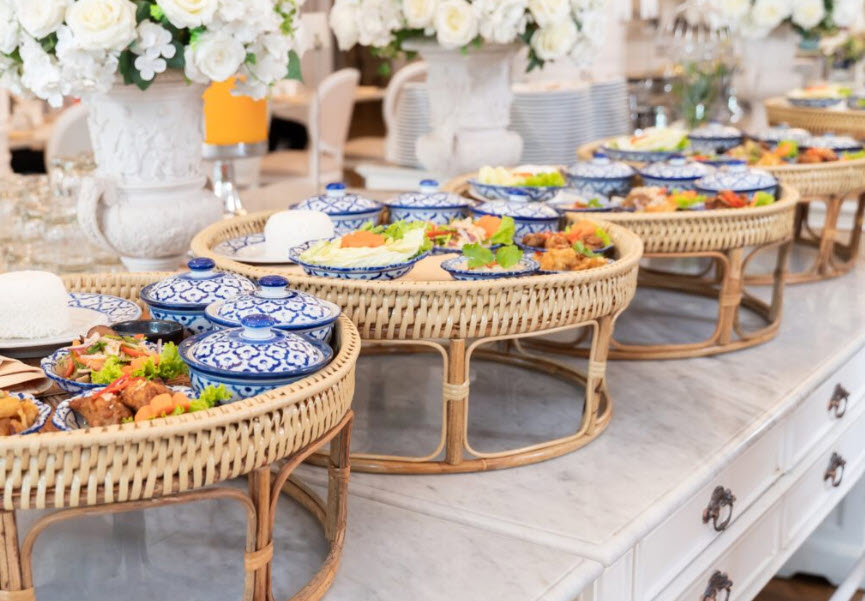
Thai Traditions and Rituals Involving Food: From Religious Ceremonies to Festivities Thai cuisine is more than just sustenance; it embodies the rich culture, beliefs, and traditions passed down through generations. From food used in religious ceremonies to dishes central to festive celebrations, every meal has its own significance and fascinating story.
Religious Ceremonies: Food in Religious Practices In daily Thai life, merit-making is a regular practice, especially in the form of offering alms to monks in the morning. This act of giving, often involving carefully prepared rice and side dishes, is a deeply rooted tradition aimed at accumulating merit. On important Buddhist days like Wan Phra and Visakha Bucha Day, offering food to monks, especially sweet treats and fresh fruits, symbolizes respect and devotion to Buddhism.
In addition, during significant regional festivals like the Bun Bang Fai Rocket Festival in the northeastern part of Thailand, food plays a vital role. Special dishes such as sticky rice with grilled pork and bamboo shoot curry reflect the unity and communal spirit of the local people.
Food in Major Festivals
Songkran, the Thai New Year, is a time for family reunions and merit-making to honor ancestors. A popular dish during this period is khao chae, a royal dish originating from the palace and renowned among the Thai elite. This cooling dish, consisting of rice soaked in cold jasmine-scented water and served with savory accompaniments like shrimp paste balls and sweetened dried fish, helps to beat the heat of summer.
During the Loy Krathong Festival, Thai people often prepare khao tom luk yon, a triangle-shaped sticky rice dessert wrapped in banana leaves, used as an offering during the floating ceremony to pay homage to the Goddess of Water and to seek blessings for a smooth life ahead.
Chinese New Year in Thailand is another occasion celebrated with an abundance of food. Thai-Chinese families offer symbolic foods like duck, pork, chicken, sticky rice cakes, and sweet sticky rice dumplings as a tribute to their ancestors and to wish for prosperity and happiness in the coming year.
Important Life Ceremonies: Food and Celebrations In Thai weddings, food plays a crucial role in symbolizing prosperity and happiness. During the khan maak procession, which is a part of the traditional wedding, nine auspicious Thai desserts such as thong yip, thong yod, and foi thong are served, each representing wealth and longevity for the couple. The food at the wedding banquet is also carefully selected to ensure it aligns with the auspicious nature of the event.
Similarly, in the ordination ceremony, food served during the celebration often includes local specialties that reflect the community’s way of life, such as Isan-style larb (a spicy minced meat salad), khao soi (northern-style curry noodles), and southern-style sour curry. These dishes are not only delicious but also carry cultural significance, symbolizing the transition of the novice into adulthood.
In Thai funerals, food is prepared to serve guests attending the ceremony. The meals are typically simple, suitable for the somber occasion, and might include dishes like rice porridge with pork, stir-fried vegetables, and fresh fruits. Preparing food during a funeral demonstrates the community’s care and support for the grieving family.
Local Food in Regional Traditions During annual merit-making ceremonies in different regions, local dishes are an essential part of the celebration. For instance, in the northeastern region, sticky rice with grilled pork and bamboo shoot soup is commonly served to guests. In the northern region, dishes like gaeng hang lay (northern-style pork curry) and steamed sticky rice are central to the celebrations during the Bun Salak Phat (Merit-Making Ceremony). These foods not only offer delicious flavors but also reflect the way of life and beliefs of the local people.
Thai cuisine is more than just food it is a symbol of culture, beliefs, and traditions that have been passed down through generations. The preparation and sharing of food in various ceremonies represent respect for the sacred and love for family and community. Preserving and promoting Thai culinary traditions is crucial for maintaining the nation’s identity and is something all Thai people can take pride in.
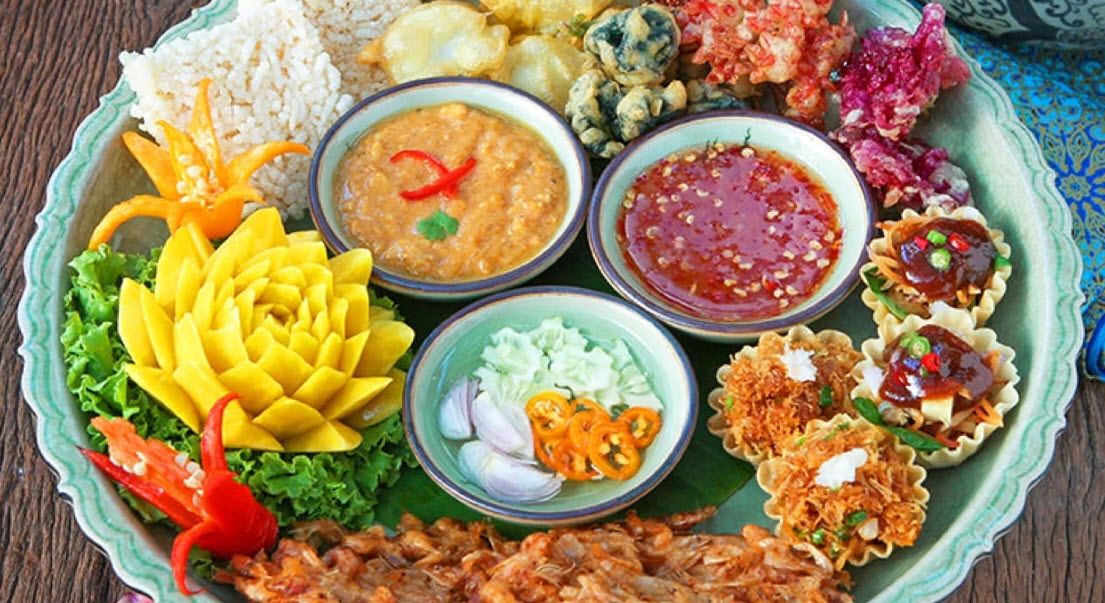
Royal Thai Cuisine: The Taste of Elegance and Refinement Royal Thai cuisine is a culinary art characterized by its meticulous preparation and exquisite detail. It reflects the unique identity and deep cultural heritage of Thailand. By blending premium ingredients with intricate presentation, royal Thai cuisine has become a valuable cultural legacy and a significant part of Thailand's history, passed down through generations.
History and Origins of Royal Thai Cuisine Royal Thai cuisine originated in the royal palaces, particularly during the Ayutthaya and Rattanakosin periods, when the Thai royal court was flourishing and played a central role in society. The dishes prepared within the palace were not only required to be delicious but also had to adhere to proper etiquette and tradition. Cooking in the royal court was an art passed down from generation to generation among the royal consorts and court ladies. This knowledge and technique were preserved and taught within the palace, forming the foundation of the royal Thai cuisine we know today.
Distinctive Characteristics of Royal Thai Cuisine Royal Thai cuisine stands out in several aspects, from ingredient preparation and cooking techniques to the elegant presentation of the dishes.
1. Meticulous Preparation Royal Thai cuisine is prepared with great care at every step, from selecting high-quality ingredients to food preparation, such as slicing, peeling, and grating, which must be done with precision. A notable example is the grinding of curry paste in a stone mortar until smooth or the fine slicing of vegetables and fruits into delicate pieces.
2. Elegant Presentation The presentation of royal Thai cuisine is an art form that requires skill and creativity. The carving of fruits and vegetables into flower or animal shapes and the balanced arrangement of food on the plate in terms of color and form all showcase the beauty and sophistication unique to royal Thai cuisine.
3. Balanced Flavors Royal Thai cuisine offers a harmonious blend of flavors without overpowering any particular taste. It combines spicy, sweet, salty, and sour elements in perfect balance, providing a pleasant and satisfying experience with every bite.
4. Selection of Ingredients The ingredients used in royal Thai cuisine are typically of the highest quality, fresh, and often rare. These include fragrant herbs, carefully selected fruits and vegetables, and premium meats. The use of these ingredients not only enhances the flavor but also adds a luxurious and refined touch to the dishes.
Popular Royal Thai Dishes Royal Thai cuisine includes several well-known dishes that are popular both within Thailand and internationally. Some of the most famous dishes include:
Kaeng Ranjuan: A curry known for its fragrant herbs and rich, balanced flavor, this dish was highly popular in the royal court and remains a favorite today.
Massaman Chicken: A curry with a sweet, creamy flavor and the aroma of spices, this dish was favored among nobles and the upper class in the past.
Khao Chae: A dish suited for the summer, consisting of rice soaked in cool jasmine-scented water, served with a variety of sweet and salty accompaniments. It was popular in the royal court and is now a well-loved dish during the Songkran Festival.
Choo Chee Pla Tu: Mackerel cooked with spicy curry paste and coconut milk, resulting in a rich, spicy, and fragrant dish that has been popular both in the past and present.
Nam Prik Long Rua: A shrimp paste dip mixed with lime and palm sugar, served with a variety of side dishes, reflecting the simplicity yet profound value in the royal court.
Royal Thai Cuisine in the Modern Era Even as time passes, the art of royal Thai cuisine continues to be preserved and passed down with great dedication. Royal Thai cuisine still plays an important role in Thai culture and has increasingly gained international recognition. In the modern era, traditional techniques from royal Thai cuisine have been blended with contemporary cooking, making these dishes more accessible while still retaining their original elegance and unique characteristics.
Royal Thai cuisine is more than just food; it is an art form that reflects the essence of Thailand in every step of its preparation and presentation. With its harmonious flavors and beautiful presentation, royal Thai cuisine is a cultural heritage worthy of preservation and transmission to future generations. The meticulous attention to detail and sophistication in every step make royal Thai cuisine a grand representation of Thailand's culture and history.
Unique Thai Dishes: Exploring Extraordinary Flavors Thailand is well-known for its diverse and unique flavors in its cuisine. However, if you think Thai food is limited to familiar dishes like Tom Yum Goong, Som Tum, or Pad Thai, you might need to think again. Thai cuisine also features some unique and unusual dishes that many people might not have heard of before. These dishes reflect the rich cultural diversity and the clever use of local ingredients.
The Diversity of Unique Thai Dishes Thailand is a melting pot of cultures and natural resources, with each region offering its own distinct culinary identity. Some dishes may seem strange or unbelievable as food, but for the locals, they are an integral part of daily life and reflect their way of living. The use of locally sourced ingredients combined with traditional wisdom has given rise to unique and fascinating dishes.
Examples of Unique Thai Dishes
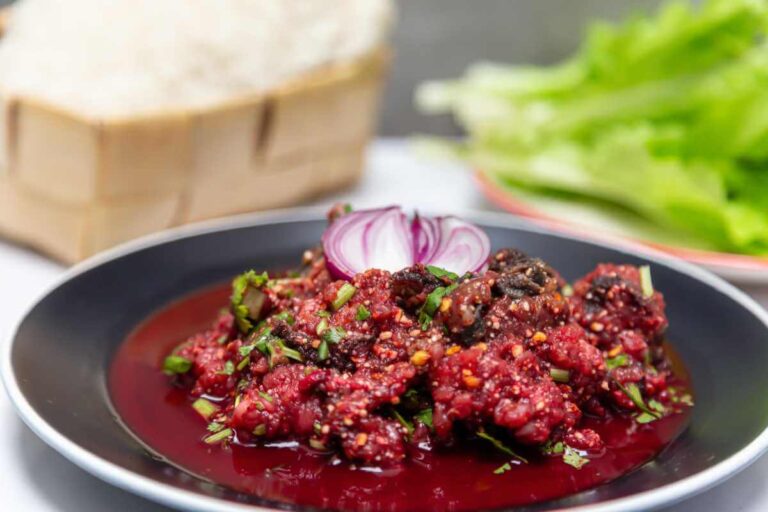
Larb Lueat (Blood Salad): Larb Lueat is a traditional dish from Northern and Northeastern Thailand that involves mixing fresh blood with raw meat and various seasonings, creating a spicy and aromatic flavor. This dish is popular in certain regions of Thailand, particularly among locals who enjoy bold and intense flavors.
Grilled Mangda (Horseshoe Crab): Grilled Mangda is a dish commonly found in Central and Northeastern Thailand. The horseshoe crab is grilled whole and served with a spicy seafood dipping sauce. Despite its strange and intimidating appearance, it is a favorite among seafood lovers due to its sweet and chewy texture.
Crispy Fried Grasshoppers: In many parts of Thailand, insects are a popular source of protein. Crispy fried grasshoppers are one of the most commonly enjoyed insect dishes, where the grasshoppers are deep-fried until crispy and often eaten as a snack or paired with drinks.
Ant Egg Soup: Ant eggs are a local delicacy found in Northeastern and Northern Thailand, often used in dishes like ant egg soup, ant egg salad, or ant egg omelets. The eggs have a slightly sour and refreshing taste with a crunchy texture, making them a favorite among those who enjoy bold and unique flavors.
Pickled Bamboo Shoot Soup: Pickled bamboo shoot soup is a traditional dish from Northern Thailand. The pickled bamboo shoots, which have a strong sour taste, are cooked with herbs and various seasonings, resulting in a spicy and tangy soup that locals enjoy for its ability to cool the body.
Frog Curry: Frog curry is a dish found in various regions of Thailand. Frogs are cooked in a spicy and rich curry paste, resulting in a dish with a spicy and aromatic flavor. The frog meat is tender and has a texture similar to chicken, but with a finer grain.
Stir-Fried Cuttlefish with Black Eggs: This rare dish features cuttlefish with eggs inside, seasoned with herbs and roasted chili paste, then stir-fried until cooked. The dish is known for its spicy flavor and the chewy texture of the cuttlefish eggs, which add a unique taste.
Flying Leaf Fish (Mang Lak): Flying leaf fish is a famous dish in Northeastern Thailand. Mang Lak, or the big leaf fish, is either fried or grilled, and it has a taste similar to shrimp but with a chewier texture. It is often enjoyed with sticky rice and a spicy dipping sauce.
The Cultural Significance of Unique Thai Dishes These unusual dishes are not just food but also an important part of local culture, reflecting the natural diversity and the way of life in different regions. The preparation of these dishes also showcases the wisdom and creativity of ancestors who made the most of local resources efficiently and effectively.
Modern Acceptance and Evolution Today, younger generations are more open to trying new foods, leading to greater awareness and appreciation of these unique dishes. Some of these dishes have also been modernized and presented in contemporary ways, making them more accessible and appealing to a broader audience, including on an international level.
Unique Thai dishes are a part of the culinary culture that reflects the diversity of natural resources and local wisdom. Although these dishes might seem strange or unappetizing to some, for adventurous eaters, trying them is a memorable experience and an excellent opportunity to gain a deeper understanding of Thai culture.
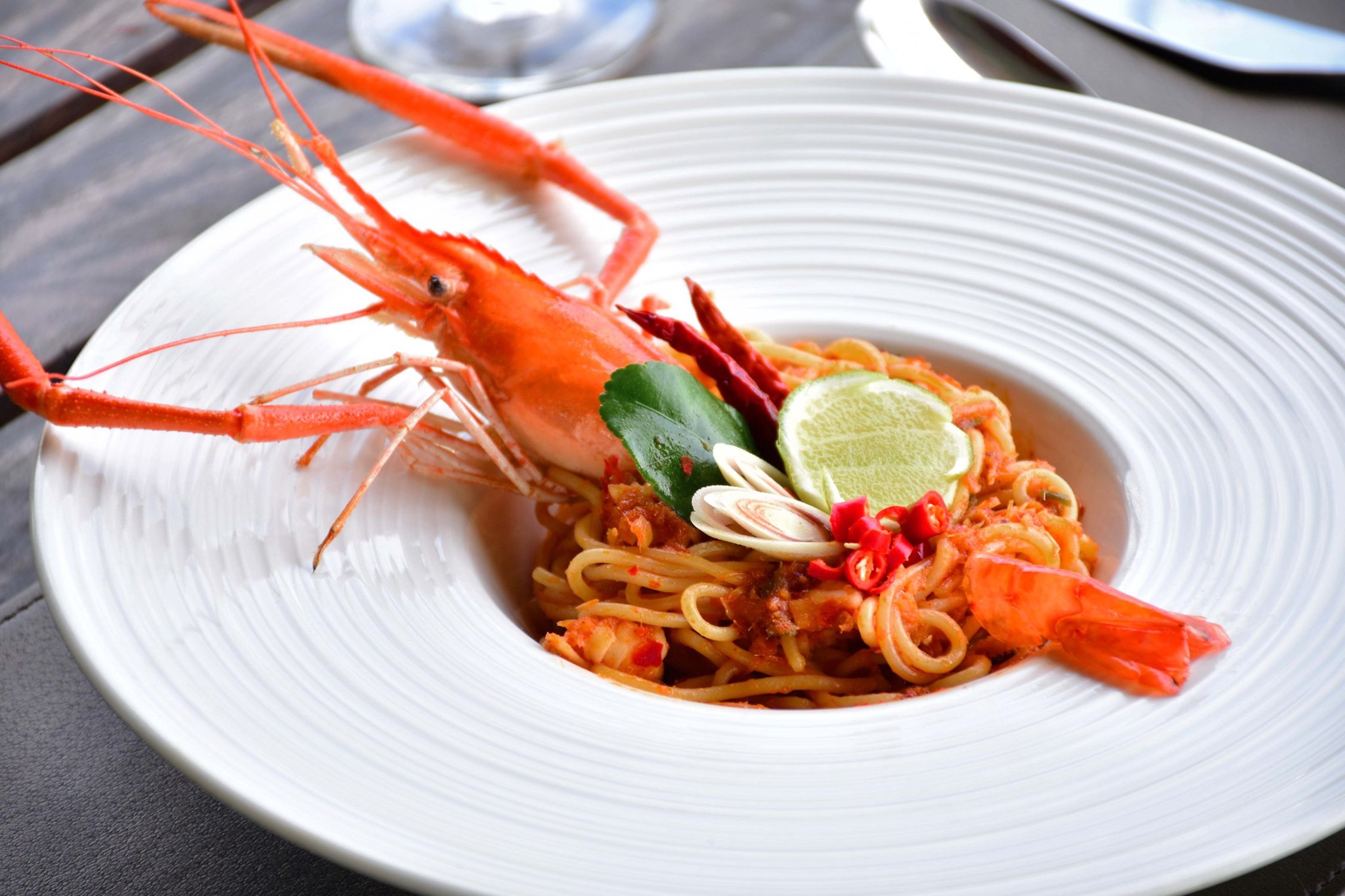
Thai Fusion Cuisine When Culinary Cultures Cross Borders Thai cuisine is renowned for its distinctive charm, known globally for its diverse flavors and fresh, spicy ingredients. The allure of Thai food lies in its delicious and rich history, with each dish telling its own unique story. In today's interconnected world, Thai food faces new challenges and opportunities as it blends with culinary traditions from other countries, giving rise to Thai fusion cuisine.
The Emergence of Thai Fusion Cuisine Fusion cuisine is not a new concept, but the blending of Thai food with other culinary traditions has gained popularity as Thai cuisine has spread internationally. Creative Thai chefs began experimenting with combining Thai flavors with techniques from other cuisines. For example, pasta green curry, sushi with Thai ingredients, and pizza topped with Thai tom yum soup.
A standout example is tom yum pizza, which features a pizza base topped with the tangy, spicy tom yum soup and large shrimp. The combination of tangy, spicy, and salty flavors in this pizza creates a unique and appealing dish that is loved by both Thai and international diners.
The Significance of Fusion Cuisine in the Thai Culinary World Thai fusion cuisine not only opens new horizons for Thai food but also creates new dishes that attract the attention of a younger audience. Maintaining the authenticity of Thai flavors while adapting to other culinary cultures is crucial. Chefs must balance preserving traditional Thai tastes with introducing innovative ideas to captivate both local and international customers.
Popular Thai Fusion Dishes Popular fusion dishes that have captured people's interest include Khao Soi burgers, which use the northern Thai Khao Soi curry as a burger component, and Spaghetti Tom Yum, which incorporates the tangy, spicy flavors of Tom Yum soup into spaghetti.
These adaptations do not mean forgetting Thai flavors but rather presenting Thai cuisine in a new, exciting way that aligns with global trends. This allows us to experience and enjoy Thai food in diverse and appealing forms.
Challenges and Opportunities for Thai Fusion Cuisine The primary challenge for Thai fusion cuisine is balancing creativity with maintaining the essence of traditional Thai food. Creating fusion dishes requires careful selection of ingredients and techniques to achieve a harmonious blend.
The global market offers significant opportunities for Thai fusion cuisine. Expanding into international markets and developing new dishes are key to gaining positive reception and building a strong brand. The potential for Thai fusion cuisine to thrive in different countries is promising.
Thai fusion cuisine represents a blending of traditional Thai flavors with innovative approaches, showcasing Thai food in new and intriguing ways. Experimentation and creativity not only provide new tasting experiences but also promote Thai culture on a global stage. Exploring Thai fusion cuisine offers an exciting way to deepen your appreciation for Thai food, and you may find yourself falling even more in love with its rich, diverse flavors.
Comment
| Keyword (Advance) |
 Facebook Fanpage
Facebook Fanpage














 Category:
Category:  Group:
Group:  Art, Culture and Heritage
Art, Culture and Heritage Historical Sites and Monuments(
Historical Sites and Monuments( Landmarks and Memorials(
Landmarks and Memorials( Royal Palace(
Royal Palace( Art, Craft Centres, Tradition(
Art, Craft Centres, Tradition( Museums(
Museums( Historical Houses and The Ancient City(
Historical Houses and The Ancient City( Art Gallery(
Art Gallery( Educational Places
Educational Places Museum for Study(
Museum for Study( Library(
Library( University
University Places of Worship
Places of Worship Temple(
Temple( Church(
Church( Mosque(
Mosque( Other religious and spiritural sites(
Other religious and spiritural sites( Research and Development
Research and Development Royal Project(
Royal Project( Suburban Living
Suburban Living Village, Community(
Village, Community( Local Market(
Local Market( Floating Market(
Floating Market( Nature and Wildlife
Nature and Wildlife River, Canal(
River, Canal( Bays and Beaches(
Bays and Beaches( Other natural attractions(
Other natural attractions( Entertainment and Agricultural
Entertainment and Agricultural Zoos and Aquariums(
Zoos and Aquariums( Animal camps and shows(
Animal camps and shows( Stadium(
Stadium( Farm, Parks, Gardens and Ecotourism(
Farm, Parks, Gardens and Ecotourism( Amusement Park(
Amusement Park( Waterpark(
Waterpark( Theater(
Theater( Cinema(
Cinema( Shopping
Shopping Shopping and Night Market(
Shopping and Night Market( Department Store(
Department Store( Spas and Wellness
Spas and Wellness Spas and Wellness(
Spas and Wellness( Restaurant
Restaurant Michelin Star(
Michelin Star( Accommodation
Accommodation Hotel(
Hotel( Call Customer Service in Tourism
Call Customer Service in Tourism Call Customer Service in Tourism(
Call Customer Service in Tourism( Royal Thai Desserts, Traditional Dessert, Thai Dessert Recipes(
Royal Thai Desserts, Traditional Dessert, Thai Dessert Recipes(